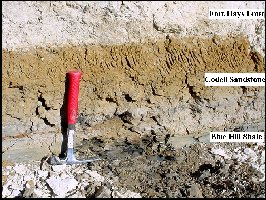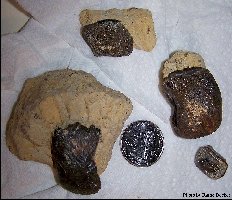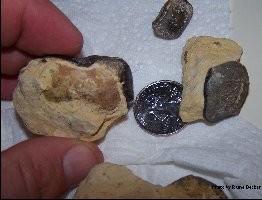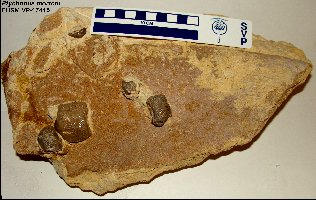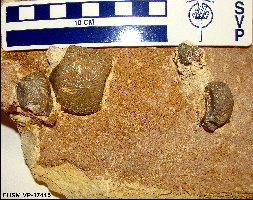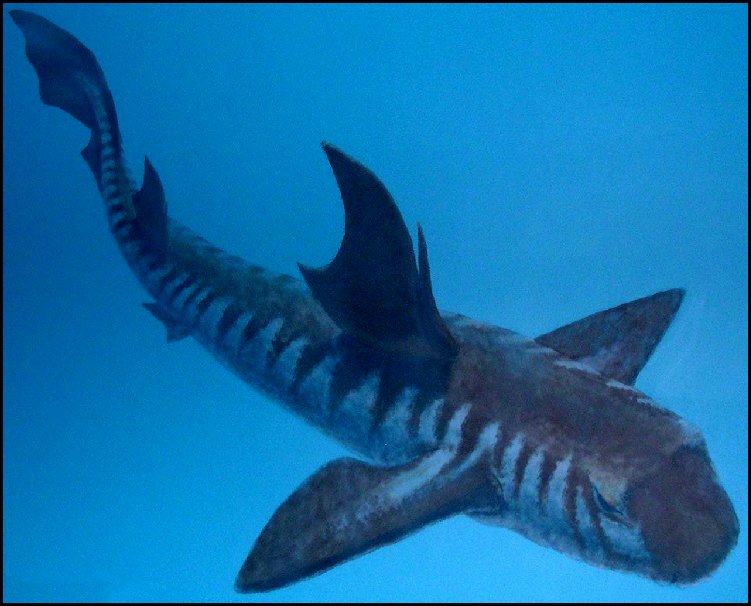 |
Ptychodus mortoni
The earliest occurrence of a giant, shell-crushing
shark in the Fort Hays Limestone
Copyright © 2011-2013 by Mike Everhart
Page Created 02/27/2010 - Last updated
08/19/2013
LEFT: An artist's reconstruction of Ptychodus
mortoni - Sternberg Museum of Natural History, Hays, Kansas. While this painting is
based on the body form of Heterodontus, the Port Jackson shark, there is evidence to indicate that Ptychodus
would have looked more like a typical lamniform. |
The recent discovery of the remains of a giant shell-crushing shark near the
Kansas-Nebraska border resulted in the publication of this paper:
Shimada, K., Everhart, M.J., Decker, R. and Decker P.D. 2010. A new skeletal remain of
the durophagous shark, Ptychodus mortoni, from the Upper Cretaceous of North
America: an indication of gigantic body size. Cretaceous Research 31(2):249-254.
This specimen represents the earliest known and documented occurrence of this
species of Ptychodus. It was found just above the contact of the Fort
Hays Limestone with the Codell Sandstone Member of the Carlile Shale and would
be early Coniacian in age (~89 ma).
The first Ptychodus mortoni tooth was
collected Alabama in the 1830s. The genus was poorly known in the North America at the
time and the tooth was initially mis-identified.
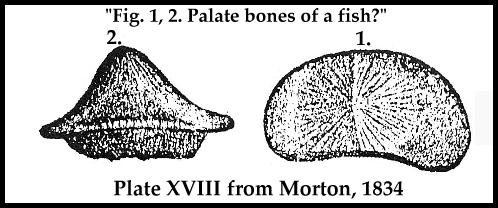 |
LEFT: The first illustration of a Ptychodus mortoni tooth was
published by Morton (1834) but was not further identified than "The palate bones of a
Fish?" The same specimen was later sent to Dr. Mantell in England for
identification. According to Morton (1842), the first tooth of Ptychodus mortoni was
found by "Mr. Conrad in the older cretaceous strata at Prairie Bluff, Alabama."
Manning (Pers. comm, 2002) indicated that is more likely that the tooth was from the
Mooreville Chalk near Erie, Alabama.
Although Morton was the first to publish the name, he did so without a description
of the tooth, assuming that Mantell had already published it. The species was officially
described and named P. mortoni by Agassiz in 1839 (Vol. 3, p. 158, pl. 25, fig.
1-3). |
Dr. G. M. Sternberg
and Professor B. F. Mudge)
were among the first to collect Ptychodus teeth from the Smoky Hill Chalk.
Mudge's contribution was acknowledged by Cope (1874) while Sternberg was credited
by Leidy (1873), including several specimens that he illustrated. In regard to the Ptychodus
mortoni teeth, Leidy noted that. "The Smithsonian Institution has submitted to
my examination a collection of fourteen specimens of teeth obtained by Dr. George M.
Sternberg, United States Army, from the banks of Chalk Bluff Creek, a branch of Smoky Hill
River, about sixty miles east of Fort Wallace, Kansas. The specimens were found in two
parcels, each together, as if pertaining to two individuals."
Ptychodus mortoni is one of five ptychodontid species documented from
the Smoky Hill Chalk Member of the Niobrara Chalk Formation (P. anonymus, P. latissimus, P.
polygyrus and P. martini are the other four). From the number of single
teeth and other remains that have been found, P. mortoni apparently was the most
common species at this time, and probably the last species of Ptychodus to be
found in the Western Interior Sea. P. mortoni became extinct in the Western
Interior Sea about the 86 million years ago, near the boundary between the Coniacian and
Santonian stages. No one is quite sure what they looked like, but from the
shark-like vertebrae associated with several specimens, it appears that they may have been
more shark-like in body form than ray-like. Judging from the size of some isolated teeth
and this specimen of 539
associated teeth (KUVP 55270) in the University of Kansas Museum of Natural History
collection, these fish probably grew to lengths of more than 5 meters. Here are some
representative (and very worn) teeth from a specimen in the Sternberg Museum of Natural
History that includes over 870 teeth (FHSM VP-335).
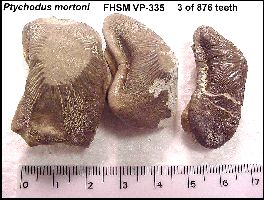 |
LEFT: Three of 876 Ptychodus mortoni teeth from a single
specimen (FHSM VP-335). Collected from Hells Bar Canyon in southwest Gove County in 1952.
Note the wear facet on the large tooth at far left. RIGHT:
Three of 112 teeth of a single specimen of Ptychodus mortoni (FHSM VP-336) from
the same locality as above. This locality represents the last (uppermost) occurrence of Ptychodus
in the Smoky Hill Chalk (Just below Marker Unit 10, Middle Santonian). |
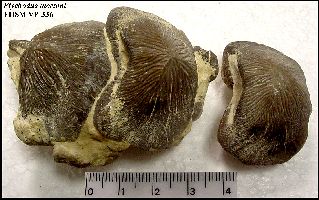 |
Since that time, many other specimens of Ptychodus
mortoni have been collected.
The most recent specimen is currently being
collected from the middle of the Smoky Hill Chalk in Logan County, Kansas.
In November, 2008, Ramo and Pam Decker were prospecting along a newly exposed
roadcut in Jewell County. What they found turned out to be the earliest documented example
of Ptychodus mortoni.
In April, 2009, Kenshu Shimada and I arranged to meet the Deckers, and then
spent most the rest of the day recovering the specimen.
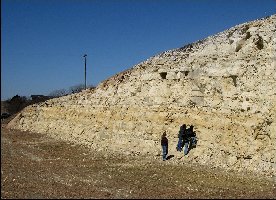 |
LEFT: Our first look at the roadcut on a bright, sunny. but
relatively cold day in early April, 2009. Ramo and Pam Decker had discovered the specimen
the previous year, after the highway had been widened and a fresh surface of nearly
vertical limestone had been exposed. Unfortunately, it appeared that much of the specimen
had been destroyed by the heavy equipment used to widen the road. RIGHT:
Ramo Decker points out the location of the specimen relative to the exposure of the basal
Fort Hays Limestone. The specimen occurred about 1.7 meters above the contact of the Fort
Hays with the underlying formation, the Codell Sandstone Member of the Carlile Shale. |
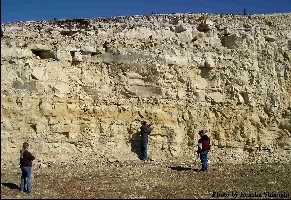 |
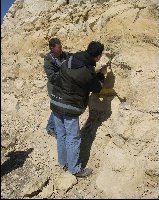 |
LEFT: Kenshu Shimada and Ramo Decker consider how best to remove
the remains. The Fort Hays Limestone is much harder than the Smoky Hill Chalk, and has
generally been avoided by collectors. The Deckers, however, have had good success in the
Fort Hays, collecting only the second plesiosaur ever found there. (SEE Fort Hays Plesiosaur web page HERE) RIGHT:
We started out using hammer and chisel, and realized very quickly that it was going to be
a long day. Ramo remembered that he had a portable drill in his truck and we decided to
give it a try. Photo by Kenshu Shimada. |
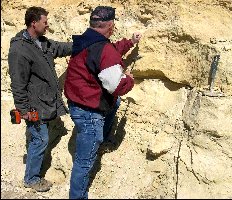 |
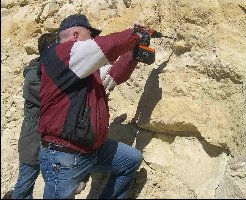 |
LEFT: Using a half inch drill bit, we were able to drill a series
of holes above and below the shark remains. We allowed enough space around the fossil to
insure that we weren't damaging it, and were mostly successful in that regard. The
drill cut through the limestone fairly easily, but we used up three fully charged
batteries in the process. RIGHT: At this point we had removed quite a
bit of matrix from under the calcified cartilage and encountered a number of teeth in the
process (circled). It was slow going most of the day. Photo by Kenshu Shimada. |
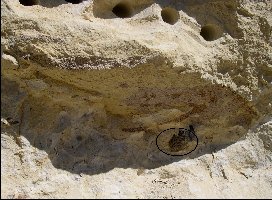 |
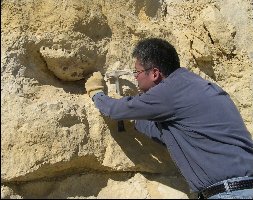 |
LEFT: Here Kenshu Shimada is working with hammer and chisel to
chip away at the limestone. RIGHT: Ramo Decker examines the limited
progress were had made. At this point, we had been working on the limestone for about 3
hours. The temperature had come up and there was no wind, so it was a very pleasant place
to work. |
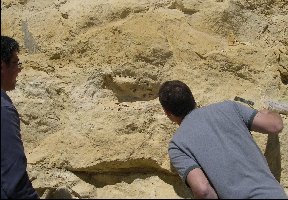 |
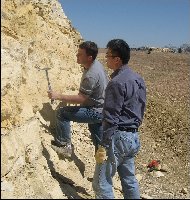 |
LEFT: Still pounding rocks early in the afternoon. We continued to
drill and chisel around the specimen, removing about a dozen teeth in the process, but
were not making a lot of progress. The limestone was a lot tougher than we had
imagined. RIGHT: Finally, about 3 PM, we managed to free the fragment
of the right upper jaw and associated teeth from the limestone wall. The photo shows
the underside of the remains. |
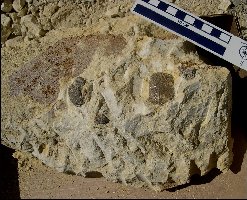 |
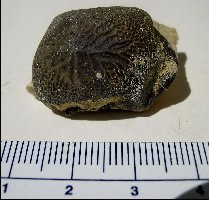 |
LEFT: Here is a field phone of one of the teeth recovered with the
specimen. (Scale = mm) RIGHT: The sad news was that a small,
anterior portion of
the jaw (palatoquadrate) remained in the excavation. We coated it with preservative and covered it back up
for a possible future dig, but it is really in a tough spot to work. We were also a little
concerned with the possibility of falling rocks as we pounded on the limestone. A few
years of natural weathering may help solve the problem. |
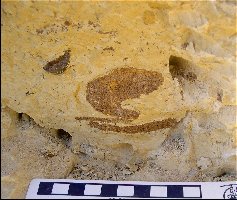 |
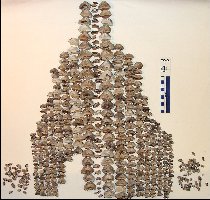 |
LEFT: This is my initial arrangement the teeth in the
upper jaw of another Ptychodus specimen collected in 2010 from the
Smoky Hill Chalk. There are about 390 teeth in
the arranged portion with two groups of 50 posterior laterals on each
side. In life, there would be no spaces between the teeth in the jaw
plate... and the little mesial teeth in the center row would not be
visible (buried in gum tissue between the two rows of larger teeth. The
reconstruction is 20 inches wide by 22 inches in length.
RIGHT: My reconstruction of the upper jaw (palatoquadrate) with an
articulated jaw plate, in ventral view, and it's relationship to a
model of Ptychodus mortoni, based on: Shimada, K., Everhart,
M.J., Decker, R. and Decker P.D. 2010. |
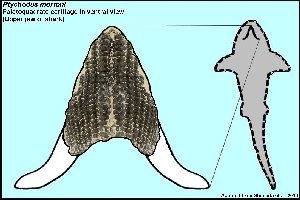 |
Suggested references on Ptychodus in Kansas and around the world:
Agassiz, J. L. R. 1833-1844.
Recherches sur les Poissons Fossiles. 3: pp. vii + 390 + 32, Neuchàtel and Soleure.
Applegate,
S. P. 1970. The vertebrate fauna of the Selma Formation of Alabama; Part VIII, The Fishes.
Fieldiana Geology Memoirs 3(8):383-433, text figs. 174-204.
Cappetta, H. 1973.
Selachians from the Carlile Shale (Turonian) of South Dakota. Journal of
Paleontology 47(3):504-514.
Cappetta, H. 1987. Chondrichthyes II - Mesozoic and Cenozoic
Elasmobranchii. Gustav Fischer Verlag, Stuttgart and New York. 193 p., 148 fig.
Case, G. R. and D. R. Schwimmer. 1988. Late Cretaceous fish from
the Blufftown Formation (Campanian) in western Georgia. Journal of Paleontology
62(2):290-301.
Case, G. R., T. T. Tokaryk and D.
Baird. 1990. Selachians from the Niobrara Formation of the Upper Cretaceous
(Coniacian) of Carrot River, Saskatchewan, Canada. Canadian Journal of Earth Sciences
27:1084-1094.
ON LINE: Cicimurri, D. 2001. Cretaceous
elasmobranchs of the Greenhorn Formation (Middle Cenomanian-Middle Turonian), western
South Dakota. p. 27-43 in V. L. Santucci and L. McClelland (eds.), Proceedings
of the Sixth Fossil Resource Conference, Geologic Resources Division Technical Report,
NPS/NRGRD/GRDTR-01/01.
Cicimurri, D. J. 2004. Late Cretaceous
chondrichthyans from the Carlile Shale (Middle Turonian to Early Coniacian) of the Black
Hills region, South Dakota and Wyoming. The Mountain Geologist 41(1):1-16.
Cope,
E. D. 1874. Review of the Vertebrata of the Cretaceous period found west of the
Mississippi River. U. S. Geological and Geographical Survey of the Territories, Bulletin
1(2):3-48.
Cope,
E. D. 1875. The Vertebrata of the Cretaceous formations of the West. Report of the
U. S. Geological Survey of the Territories (Hayden). 2:302 pp., 57 pls.
Dibley,
G. E. 1911. On the teeth of Ptychodus and their distribution the
English Chalk. Quarterly Journal of the Geological Society of London 67:263-277, pls.
17-22.
Everhart, M. J.
2003. First records of plesiosaurs from the lower Smoky Hill Chalk Member (Upper Coniacian) of the Niobrara Formation of western
Kansas. Kansas Academy of
Science, Transactions 106(3-4):139-148.
Everhart, M.J. 2013.The Palate Bones of a Fish?” – The First Specimen
of Ptychodus mortoni (Chondrichthyes; Elasmobranchii) from Alabama.
Bulletin of the Alabama Museum of Natural History 31(1):98-104.
Everhart, M. J. and Caggiano, T.
2004. An associated dentition and calcified vertebral centra of the Late
Cretaceous elasmobranch, Ptychodus anonymus Williston 1900. Paludicola 4(4), p. 125-136.
Everhart, M. J., T. Caggiano, and K. Shimada. 2003. Note on
the occurrence of five species of ptychodontid sharks from a single locality in the Smoky
Hill Chalk (Late Cretaceous) of western Kansas. (Abstract) Kansas Academy of Science,
Transactions 22:29.
Evetts, M. J. 1979. Upper Cretaceous sharks from the Black Hills
region, Wyoming and South Dakota. The Mountain Geologist, 16(2):59-66.
Gibbes, R. W., 1848. Monograph of the fossil
Squalidae of the United States. Jour. Acad. Nat. Sci. Phila. Vol. 1, 2nd Ser., pt.
2, art. 12:139-147. pls. 18-21 (Ptychodus polygyrus).
Hamm
,
S.A.
2010. The Late Cretaceous
shark, Ptychodus rugosus, (Ptychodontidae) in the
Western
Interior
Sea
.
Kansas
Academy
of Science, Transactions 113(1-2):44-55.
Hamm
,
S.A.
2010.
The Late Cretaceous shark Ptychodus marginalis in the Western Interior
Seaway
,
USA
. Journal of Paleontology 84(3):538-554
Hamm, S. A. and M. J. Everhart. 1999. The occurrence
of a rare ptychodid shark from the Smoky Hill Chalk (Upper Cretaceous) of western Kansas.
Kansas Academy of Science, Transactions (Abstracts) 18:34.
Hamm, S. A. and K. Shimada. 2002.
Associated tooth set of the Late Cretaceous lamniform shark, Scapanorhynchus raphiodon
(Mitsukurinidae), from the Niobrara Chalk of western Kansas. Kansas Academy of Science,
Transactions 105(1-2):18-26. Hattin, D. E. 1982. Stratigraphy and depositional
environment of the Smoky Hill Chalk Member, Niobrara Chalk (Upper Cretaceous) of the type
area, western Kansas. Kansas Geological Survey Bulletin 225:108 pp.
Herman, J. 1977. Les sélaciens des terrains néocrétacés et paléocenes de Belgique et des contrées
limitrophes. Eléments d’une biostratigraphique inter-continentale. Mémoires pour
sérvir a l'explication des Cartes géologiques et miniéres de la Belgique. Service Géoligique de
Belgique, Mémoire 15, 401 pp.
Kauffman, E. G.
1972. Ptychodus predation upon a Cretaceous Inoceramus. Journal
of Paleontology 15(3):439-444.
Leidy, J. 1868. Notice of American species of Ptychodus.
Proceedings of the Academy of Natural Sciences of Philadelphia 20:205-208.
Leidy, J. 1873. Contributions to the extinct
vertebrate fauna of the western territories. Report of the U.S. Geological Survey of the
Territories (Hayden), 1:358 pp., 37 pls.
Lucas, S. G., B. S. Kues, S. N. Hayden, B. D. Allen, K. K.
Kietzke, T. E. Williamson, P. Sealy, and R. Pence. 1988. Cretaceous stratigraphy and
biostratigraphy, Cookes Range, Luna County, New Mexico. New Mexico Geological Society
Guidebook, 39th Field Conference 143-167.
MacLeod, N. and B. H. Slaughter. 1980. A
new ptychodontid shark from the Upper Cretaceous of northeast Texas. The Texas
Journal of Science 32(4):333-335.
MacLeod, N. 1982. The first North American
occurrence of the Late Cretaceous elasmobranch Ptychodus rugosus Dixon with
comments on the functional morphology of the dentition and dermal denticles. Journal
of Paleontology 56(2): 520-524.
Manning, E. M. and D. T. Dockery III. 1992. A
guide to the Frankstown vertebrate fossil locality (Upper Cretaceous), Prentiss County,
Mississippi. Mississippi Department Environmental Quality, Office of Geology Circular 4:43
pp., 2 pl.
Meyer,
R. L. 1974. Late Cretaceous elasmobranchs from the Mississippi and east Texas
embayments of the Gulf Coastal Plain. Unpublished doctoral dissertation, Southern Methodist University, Dallas, 400pp.
Morton, S. G., 1834. Synopsis of the organic
remains of the Cretaceous group of the United States. Key and Biddle, Philadelphia, 88
pp., 19 pl.
Morton, S. G. 1842. Description of some new
species of organic remains of the Cretaceous group of the United States; with a tabular
view of the fossils hitherto discovered in this formation. Journal of the Academy of
Natural Sciences of Philadelphia. 8:207-227, 2 pl.
Mudge, B. F. 1876. Notes on
the Tertiary and Cretaceous periods of Kansas. Bulletin of the U. S. Geological Survey of
the Territories (Hayden), 2(3):211-221.
Nicholls, E. L. 1988.
New material of Toxochelys latiremis Cope, and a revision of the genus
Toxochelys (Testudines, Chelonoidea). Journal of Vertebrate Paleontology
8(2):181-187.
Parkin,
J. A., K. Shimada, and B. A. Schumacher. 2002. Fossil fishes from the
lowermost Greenhorn Limestone (Upper Cretaceous: Middle Cenomanian) in southeastern
Colorado. Paper No. 187-15, Geological Society of American Annual Meeting.
Schwimmer,
D. R., J. D. Stewart and G. D. Williams. 1997. Scavenging by sharks of the
genus Squalicorax in the Late Cretaceous of North America. Palaios 12:71-83.
Shimada, K. 1993. Upper Cretaceous
elasmobranchs from the Blue Hill Shale Member of the Carlile Shale, Western Kansas. Kansas
Academy of Science, Transactions 12(78).
Shimada,
K. 1996. Selachians from the Fort Hays Limestone Member of the Niobrara Chalk (Upper
Cretaceous), Ellis County, Kansas. Kansas Academy of Science, Transactions 99(1-2):1-15.
Shimada, K. and Everhart, M.J. 2003. Ptychodus
mammillaris (Elasmobranchii) and Enchodus cf. shumardi (Teleostei) from
the Fort Hays Limestone Member of the Niobrara Chalk (Upper Cretaceous) in Ellis County,
Kansas. Kansas Academy of Science, Transactions 106(3-4):171-176.
Shimada, K., Everhart, M.J.,
Decker, R. and Decker P.D. 2010. A new skeletal remain of the durophagous shark, Ptychodus
mortoni, from the Upper Cretaceous of North America: an indication of gigantic body
size. Cretaceous Research 31(2):249-254.
Shimada, K. and D. J. Martin. 1993. Upper
Cretaceous selachians from the basal Greenhorn Limestone in Russell Co., Kansas. Kansas
Academy of Science, Transactions 12:78.
Skelton, L. H.
1996. A brief history of the Kansas Academy of Science. Kansas Academy of Science,
Transactions 101(3-4):140-145.
Stewart, J. D. 1980. Reevaluation of the
phylogenetic position of the Ptychodontidae. Abstracts of Papers, Kansas Academy of
Science, Transactions 83(3):154.
Stewart, J. D. 1988. Paleoecology
and the first North American west coast record of the shark genus Ptychodus.
Journal of Vertebrate Paleontology, 8:27A.
Stewart, J. D. 1990. Niobrara
Formation vertebrate stratigraphy. Pages 19-30, in S. C. Bennett, (ed.), Niobrara Chalk
Excursion Guidebook. University of Kansas Museum of Natural History and Kansas Geological
Survey.
Welton, B. J. and R. F. Farish.
1993. The collectors guide to fossil sharks and rays from the Cretaceous of
Texas. Horton Printing Company, Dallas, 204 pp.
Williamson, T. E., J. I. Kirkland and S. G.
Lucas. 1993. Selachians from the Greenhorn cyclothem ("Middle" Cretaceous:
Cenomanian-Turonian), Black Mesa, Arizona, and the paleogeographic distribution of Late
Cretaceous selachians. Journal of Paleontology 67(3):447-474.
Williamson, T. E., S. G. Lucas and J. I.
Kirkland. 1990. The Cretaceous elasmobranch Ptychodus decurrens Agassiz from North
America. Geobios 24(5):595-599.
Williston, S. W. 1900. Cretaceous fishes [of
Kansas]. Selachians and Pycnodonts. University Geological Survey Kansas VI pp.
237-256, with pls.
Woodward, A. S. 1887. On the dentition
and affinities of the selachian genus Ptychodus Agassiz. Quarterly Journal of the
Geological Society 43:121-131, 1 pl.
Woodward, A.S.
1904. On the jaws of Ptychodus from the chalk. Quarterly Journal
Geological Society London 60:133-136, 1 fig., pl. XV.
LINKS: Ptychodus mortoni -
A shell-crushing shark from the Late Cretaceous of western Kansas
Sharks teeth by the hundreds - A
nearly complete specimen of Ptychodus anonymus from Kansas
Ptychodus sharks teeth from
around the world including Ptychodus teeth from the English
chalk.
Jim Bourdon's Ptychodus
pages - The Life and Times of Long Dead Sharks
Kansas Sharks - Kansas shark
teeth from the Lower Permian through the Upper Cretaceous.
More here on Ptychodus
from the English Chalk - Robert Randall's British Chalk Fossils web
site





